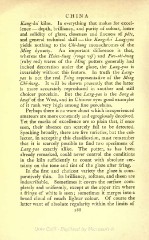Page 354 - Oriental Series Japan and China, Brinkly
P. 354
CHINA
Kang-hsi kilns. In everything that makes for excel-
lence depth, brilliancy, and purity of colour, lustre
and solidity of glaze, closeness and fineness of pate,
and general technical skill the Kang-hsi Lang-yao
yields nothing to the Chi-hung monochromes of the
Ming dynasty. An important difference is that,
whereas the Hsien-hung (rouge vif) and Pao-shi-hung
(ruby red) wares of the Ming potters generally had
incised decoration under the glaze, the Lang-yao is
invariably without this feature. In truth the Lang-
yao is not the real Tsing representative of the Ming
Chi-hung. It will be shown presently that the latter
is more accurately reproduced in another and still
choicer porcelain. But the Lang-yao is the Sang de
bceuf of the West, and in Chinese eyes good examples
of it rank very high among fine porcelains.
Perhaps there is no ware about which inexperienced
amateurs are more constantly and egregiously deceived.
Yet the marks of excellence are so plain that, if once
seen, their absence can scarcely fail to be detected.
Speaking broadly, there are five varieties, but the col-
lector, in accepting this classification, must remember
that it is scarcely possible to find two specimens of
Lang-yao exactly alike. The potter, as has been
already remarked, could never control the conditions
in the kiln sufficiently to count with absolute cer-
tainty on the tone and tint of the glaze after firing.
In the first and choicest variety the glaze is com-
paratively thin. Its brilliancy, softness, and sheen are
indescribable. Sometimes it covers the surface com-
pletely and uniformly, except at the upper rim where
a fringe of white is seen ; sometimes it merges into a
broad cloud of much lighter colour. Of course the
latter want of absolute regularity within the limits of
288

